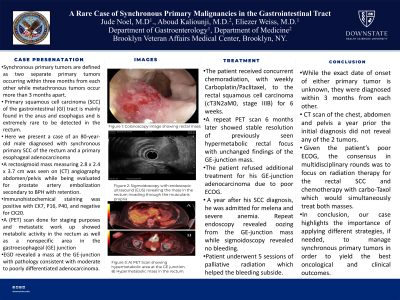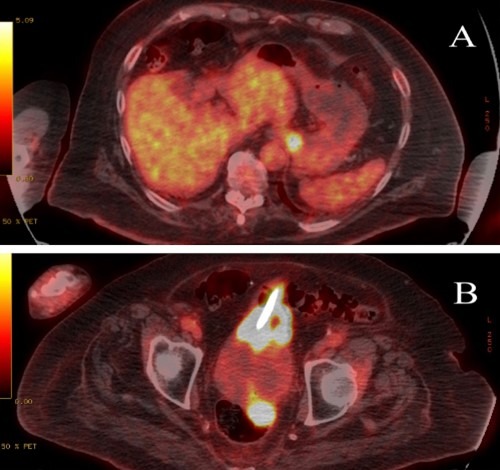Sunday Poster Session
Category: Esophagus
P0494 - An Interesting Case of Synchronous Primary Malignancies in the Gastrointestinal Tract
Sunday, October 22, 2023
3:30 PM - 7:00 PM PT
Location: Exhibit Hall

Has Audio
- JN
Jude Noel, MD
SUNY Downstate Health Sciences University
Brooklyn, New York
Presenting Author(s)
Jude Noel, MD, Aboud Kaliounji, MD, Eliezer Weiss, MD
SUNY Downstate Health Sciences University, Brooklyn, NY
Introduction: Synchronous primary tumors are defined as two separate primary tumors occurring within three months from each while metachronous tumors occur more than three months apart. Primary squamous cell carcinoma (SCC) of the gastrointestinal (GI) tract are mainly found in the anal canal and esophagus. Primary colorectal SCC is extremely rare to detect. Because of its rarity, the pathogenesis, risk factors, etiology, prognosis, and optimal treatment have not been entirely established. Here we present a case of an 80-year-old male diagnosed with synchronous primary SCC of the rectum and a primary esophageal adenocarcinoma.
Case Description/Methods: A 80-year-old male was referred to GI clinic for a rectal mass measuring 2.8 x 2.4 x 3.7 cm found incidentally on computed tomography (CT) angiography of abdomen/pelvis. A colonoscopy demonstrated the mass in the rectum with pathology consistent with invasive primary SCC. Immunohistochemical staining was positive with CK7, P16, P40, and negative for CK20. PET-CT scan done for metastatic workup showed metabolic activity in the rectum and a hypermetabolic area in the gastroesophageal (GE) junction. Upper endoscopy revealed poorly differentiated adenocarcinoma at the GE junction. The patient received concurrent chemoradiation, with weekly Carboplatin/Paclitaxel, to the rectal SCC (cT3N2aM0, stage IIIB) for a total of 6 weeks. No specific treatment for his GE-junction mass was initiated due to poor performance status but he eventually received 5 palliative radiation sessions for severe upper GI bleed from the oozing GE junction mass. Patient refused any subsequent treatment following discharge.
Discussion: Primary SCC of the rectum is an extremely rare type of neoplasm. Rectal adenocarcinoma is the most common histological type of rectal cancer. In addition to that, it is extremely rare for primary tumors to occur synchronously. Patients presenting with more than one primary tumor usually involve more than one organ system and happen metachronously rather than synchronously. Our patient presented with two synchronous primary malignancies involving one organ system: the GI tract. One study showed that of 109,054 patients who were diagnosed with a first solid tumor, only 1.36% developed multiple primary tumors. 70.87% of the second primary tumors happened metachronously, while 29.13% synchronously. While surgery remains the standard treatment of rectal SCC, promising results are emerging in patients treated with chemoradiation.

Disclosures:
Jude Noel, MD, Aboud Kaliounji, MD, Eliezer Weiss, MD. P0494 - An Interesting Case of Synchronous Primary Malignancies in the Gastrointestinal Tract, ACG 2023 Annual Scientific Meeting Abstracts. Vancouver, BC, Canada: American College of Gastroenterology.
SUNY Downstate Health Sciences University, Brooklyn, NY
Introduction: Synchronous primary tumors are defined as two separate primary tumors occurring within three months from each while metachronous tumors occur more than three months apart. Primary squamous cell carcinoma (SCC) of the gastrointestinal (GI) tract are mainly found in the anal canal and esophagus. Primary colorectal SCC is extremely rare to detect. Because of its rarity, the pathogenesis, risk factors, etiology, prognosis, and optimal treatment have not been entirely established. Here we present a case of an 80-year-old male diagnosed with synchronous primary SCC of the rectum and a primary esophageal adenocarcinoma.
Case Description/Methods: A 80-year-old male was referred to GI clinic for a rectal mass measuring 2.8 x 2.4 x 3.7 cm found incidentally on computed tomography (CT) angiography of abdomen/pelvis. A colonoscopy demonstrated the mass in the rectum with pathology consistent with invasive primary SCC. Immunohistochemical staining was positive with CK7, P16, P40, and negative for CK20. PET-CT scan done for metastatic workup showed metabolic activity in the rectum and a hypermetabolic area in the gastroesophageal (GE) junction. Upper endoscopy revealed poorly differentiated adenocarcinoma at the GE junction. The patient received concurrent chemoradiation, with weekly Carboplatin/Paclitaxel, to the rectal SCC (cT3N2aM0, stage IIIB) for a total of 6 weeks. No specific treatment for his GE-junction mass was initiated due to poor performance status but he eventually received 5 palliative radiation sessions for severe upper GI bleed from the oozing GE junction mass. Patient refused any subsequent treatment following discharge.
Discussion: Primary SCC of the rectum is an extremely rare type of neoplasm. Rectal adenocarcinoma is the most common histological type of rectal cancer. In addition to that, it is extremely rare for primary tumors to occur synchronously. Patients presenting with more than one primary tumor usually involve more than one organ system and happen metachronously rather than synchronously. Our patient presented with two synchronous primary malignancies involving one organ system: the GI tract. One study showed that of 109,054 patients who were diagnosed with a first solid tumor, only 1.36% developed multiple primary tumors. 70.87% of the second primary tumors happened metachronously, while 29.13% synchronously. While surgery remains the standard treatment of rectal SCC, promising results are emerging in patients treated with chemoradiation.

Figure: PET CT
Disclosures:
Jude Noel indicated no relevant financial relationships.
Aboud Kaliounji indicated no relevant financial relationships.
Eliezer Weiss indicated no relevant financial relationships.
Jude Noel, MD, Aboud Kaliounji, MD, Eliezer Weiss, MD. P0494 - An Interesting Case of Synchronous Primary Malignancies in the Gastrointestinal Tract, ACG 2023 Annual Scientific Meeting Abstracts. Vancouver, BC, Canada: American College of Gastroenterology.
